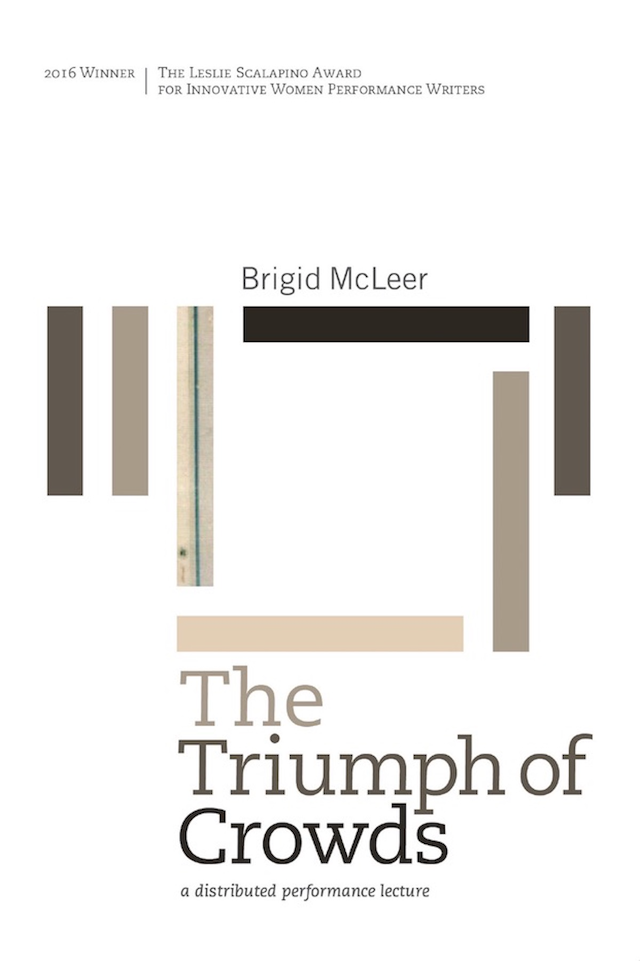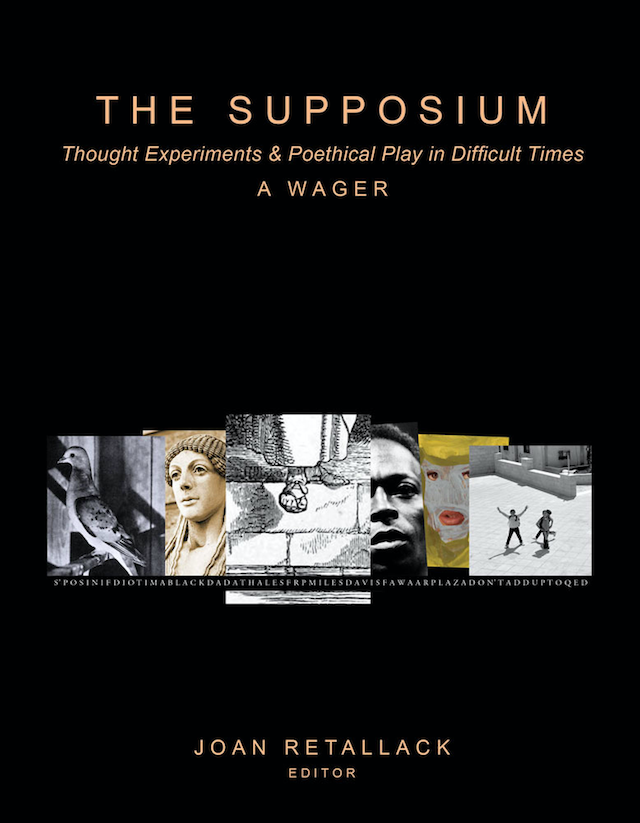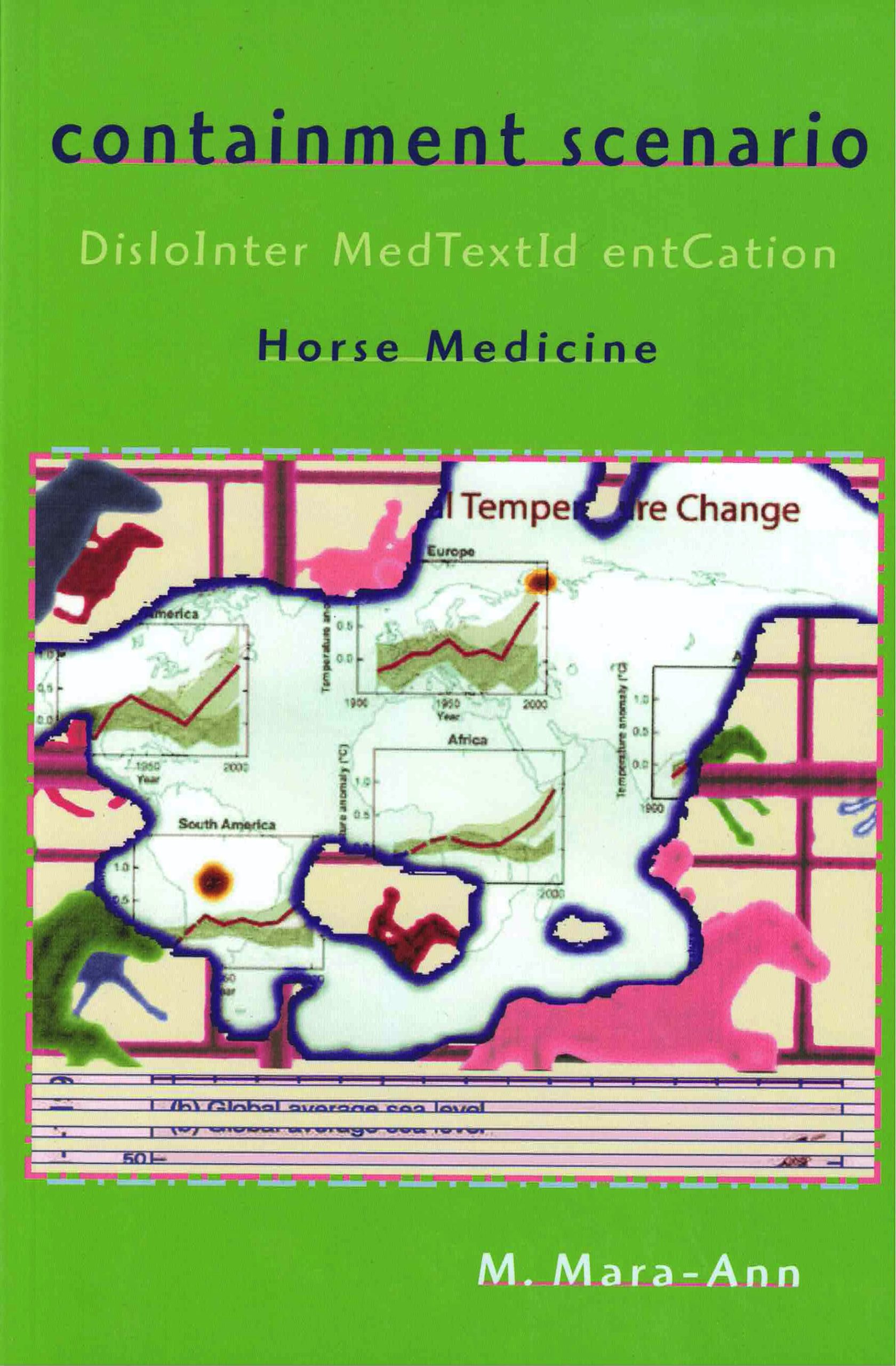Features reviews, discussion questions, and writing exercises for The Triumph of Crowds: A Distributed Performance Lecture, by Brigid McLeer; The Supposium: Thought Experiments and Poethical Play in Difficult Times, edited by Joan Retallack; and containment scenario: DisLoInter MedTextId entCation : Horse Medicine, by M. Mara-Ann.
Jump to: Book Descriptions · Lesson Planning · Reviews · Supplementary Materials · Contributor Bios
The Triumph of Crowds
The Triumph of Crowds by Brigid McLeer is a lecture as performance, or performance as lecture, distributed between the voices and gestures of ten performers. Written in conversation with Nicholas Poussin’s painting The Triumph of David (1631), The Triumph of Crowds asks the question “What does it mean to appear politically?” In McLeer’s invented form of the “distributed performance lecture,” the author undertakes an aesthetic experiment in leveling the structured spaces in which political discourse and actions occur. Triumph unfolds in the space of a “pause” and scatters its performance “across so many bodies, images, objects, voices and sounds” to explore the politics of public assembly, protest, and becoming “us.”
The Supposium: Thought Experiments and Poethical Play in Difficult Times
The Supposium is a multi-genre catalog of seriously humorous and grave responses to the crises of attention and value our human plurality is so spectacularly prone to. Edited by Joan Retallack, this book is documentation and continuation of an x-centric event held at MoMA, organized by Retallack and artist Adam Pendleton.
Black Dada vis-à-vis Black Lives Matter; misogyny as Feminist Responsibility Project; the art of If; decolonizing the architecture of a Palestinian refugee camp; Miles Davis’s and other’s s’posin; and of course Fall Guys. With all that, THE SUPPOSIUM is a polyvocal attempt to edge beyond default geometries of attention and enact poethical experiments. Its implicitly conversational sequence is homage and play on Plato’s Symposium — Socratic dialogue on the nature of love (erōs) with its humor, gravitas, and improbable feminine swerve out of a prototypic masculine culture.
Contributors include Lauren Bakst, Lynne Beckenstein, Nova Benway, Allie Biswas, Anne Carson, Alan Devenish, Sandi Hilal, Alhena Katsof, erica kaufman, John Keene, Peter Krapp, Fred Moten, Adam Pendleton, Evelyn Reilly, Danica Savonick, Ingrid Schaffner, Beverly Semmes, James Sherry, and Mónica de la Torre.
containment scenario: DisLoInter MedTextId entCation : Horse Medicine
M. Mara-Ann’s long hybrid, hypnotic poem-theater work of spoken-music text is ecological structure based on the international report on global warming. The footnote-archipelagos require one to turn back to the origin and reorient one’s reading becoming sustained attention, a holding of sounds like plateaus in the air, an inevitable letting go allowing the original’s spot (place) in the text and one’s attention to it to be lost, before one finds one’s way again. The poem’s reading is exchange “causing” the reader to hold a place in enlarging space. The content is the transience of life in its alteration—also our seeing that the outsides and insides are ending.
Discussion Questions
- Each of these books plays with what Joan Retallack calls our default geometries of attention. What might this phrase mean? Discuss.
- Now choose a small section of each book. Leaf through the pages and let your senses – visual, tactile, oral, intuitive – guide you in your “reading.” Which words, phrases, fonts, images and blank spaces feel “magnetic”? Which pages and paragraphs make you want to linger? Write down page numbers and words. What devices in these texts nudge you beyond your default geometries of attention?
- Performance art or live art usually contains five basic elements: time, space, body, presence of the artist(s), and the relationship between the creator and the public (audience). Discuss these five elements as they pertain to each book. Is one element more pronounced than the other? Choose examples from each text.
- Building on the basic elements of live art: how do you translate each element into writing? What turns a written text into a performance? And what, in your opinion, makes a written text unstageable?
- The Triumph of Crowds centers its work around “a pause” by utilizing an empty space as the site for performance. In which ways do containment scenario and The Supposium create literary moments that create “a pause” for the reader? Choose examples.
The Supposium
- Let’s create a poethical constellation to think with: look at the index of The Supposium and choose three contributions. Take a piece of paper and draw a (large) triangle. Now choose a sentence from each contribution and copy it into each corner of your triangle. How do the fragments change meaning when read alongside each other? How might the corners contradict and/or enrich each other?
The Triumph of Crowds
- In The Triumph of Crowds, “The Illustrator” tells the audience that “These words in the mouth of another are here to trouble ‘I’” (p.29). What is your idea of “I”? How is it being troubled here? Can you track the usage of “I’” throughout the play? Refer to pp.30, 32, and 60 for some guiding examples.
- What might this book be saying about the power/possibility that exists within a collective or crowd? Consider the speech on p. 45, Occupy Wall Street, the protests for Jyoti Singh, as well as the general practice of collective resistance.
containment scenario
- containment scenario employs different languages: binary code, advertisement, algorithms; what other languages might you recognize in Containment Scenario? What is the intention of each language? Are there any speakers in the text? Characters? How would you describe them?
- M. Mara-Ann adapted containment scenario for a five part inter-media performance series, exploring the discourse around the climate crisis through the lens of improvisational music-dance-theater. Look at some of the series’ documentation, then return to the book. How does engaging with the performance inform your understanding of the text?
Writing & Performance Exercises
The Triumph of Crowds
- In the “Scenario,” McLeer tells us that performance occurs in an “empty space” in that “it doesn’t already contain an apparatus for viewing. There are seats, no stage…” From this emptiness a collective movement develops. The play is also a reversal of Poussin’s The Triumph of David, which centers its event around a single hero.
Let’s play with the concept of empty space and what can grow from there:
-
- Break into small groups.
- Tape a big piece of paper onto a wall (or an easel). You are going to create a collective drawing.
- Each person takes a 3-minute turn to draw an element from a collective action (a character, an object, a setting, etc.) onto your piece of paper.
- Each person adds onto what the previous artist has drawn.
- For those of you who are not drawing: you are a tiny audience watching the drawing grow.
- Let the collective action unfold for at least 15 minutes or until each of you has taken 3-5 turns.
- After each artist has taken their turn, talk about your drawing. What does it remind you of? Consider the empty space that still remains. Where, if anywhere, is the (compositional, energetic) center of your drawing?
The Supposium
- Choose a piece in The Supposium to stage. Try to incorporate sound, text and movement.
- Retallack invites us to suppose. Take a few deep breaths. Do 10 minutes of free writing beginning each sentence with “I suppose…”
Your suppositions can be anything from apocalyptic to mundane. If you’re lost for writing, describe what’s immediately around you (I suppose this table is made of wood, etc.) until something else comes up. Don’t lift your pen off the page. Let it be pleasurable. Now look at your free write. Choose two sentences that make you curious. What do they tell you about this moment in time? What worlds do these suppositions help you imagine? Where do they fall short? - The Supposium is based on Plato’s Symposium, wherein a group of thinkers gather around a banquet and discuss the nature of Love and Knowledge. Let’s stage our own impromptu Symposium à la Plato and Retallack.
- Split into groups of at least 4 players.
- Choose a line from The Supposium or a quote from your present class/conversation. This will be the title for your “discussion.”
- After you have agreed on your line, take 15 minutes to prepare a response. Your response can take any form. You are encouraged to choose a form that is not traditionally thought of as “art.” A science experiment. A public service announcement. A commercial. Etcetera! Think of Retallack’s multidisciplinary participants and allow yourself to be playful.
- Each player presents their contribution.
- Optional: Everything is better as a potluck! Ask all participants to bring a dish to share and finish your Symposium with a banquet.
containment scenario
-
- containment scenario employs a variety of fonts to communicate with the reader. Write a line of poetry. Change it into five different fonts and notice what changes for you as you read the familiar line.
- Split into groups of 4-5 people. Each group devises its own way of interpreting The Soliloquy (p. 107), Endnotes (p.174) or a selection of your choice into a vocal score. The session ends with a showing of your performances.
All Books
- Can you think of a collective action or event that you have been to recently? A lot can count as an “event.” It could be a show, gig, or dinner with friends. Now try to translate your event into a written text. Taking inspiration from the three texts, you can incorporate setting, dialogue, poetry, blank space, images, etc.
- Take lines from all three books and collage them into a poem. Turn the poem into a scene to be acted out.
- Find an excerpt of media (music video, painting, etc.) and translate the work into one page of text. Then, return to the five ingredients of live art and try to incorporate at least two of them into your writing.
The Triumph of Crowds
Announcement of The Leslie Scalapino Award for Innovative Women Playwrights @ Poetry Foundation
The Supposium
Mónica de la Torre reviews The Supposium at MoMA @ Bomb Magazine
Lynne Beckenstein & Danica Savonick review The Supposium at MoMA @ CUNY Academic Commons
containment scenario
CatSynth reviews Containment Scenario performance series @ CatSynth
Containment Scenario: Profound Fatigue @ Emergency Index
The Triumph of Crowds
The Supposium
containment scenario
Extending the Conversation
This section introduces the work of selected artists and authors whose work intersects with titles in this Teaching Guide. We hope that this presents an opportunity for further independent exploration.
- The Clearing by Jjjjjerome Ellis
- Listening to Reading by Stephen Radcliffe (Suny Press 2000)
- Death Star/rico-chet by Judith Goldman (O Books 2006)
- IPCC report: The Physical Science Basis
- Step Across The Border, on Fred Frith, directed by Nicolas Humbert and Werner Penzel
- Fred Moten’s Radical Critique of the Present
Brigid McLeer
Brigid McLeer is an Irish artist working between disciplines and across genres. Her work has been made for galleries, public sites, the page, online and combinations thereof. Her academic career has included teaching posts at many UK universities and between 1995-2000 she co-wrote and lectured on the pioneering degree course “Performance Writing” at Dartington College of Arts. She is currently a researcher at the Royal College of Art, London. She lives and works in London, England.
Joan Retallack
Joan Retallack is a poet and essayist with a background in philosophy and visual arts. She has received a Lannan Poetry Award, a Pushcart Prize, and two Gertrude Stein Awards. Her friendship with John Cage led to MUSICAGE (Wesleyan), a volume of their conversations on Cage’s compositional poetics. Retallack’s The Poethical Wager (California) is a widely influential sequence of experimental essays on ethics and poetics, as well as the form of the essay itself. BOSCH’D—Fables, Moral Tales & Other Awkward Constructions (Litmus Press, 2020) rejiggers ancient and contemporary wagers on textual forms of “poethical courage.” With gravitas and humor, Retallack considers our species’ best and worst proclivities in medias res of the Anthropocene.
M. Mara-Ann
As an artist working with language, M. Mara-Ann expresses her creativity through writing, singing, and intermedia performance. Inspired by the musical qualities of language, the architecture of text and meaning, her love of theory and science, and the interplay between nature and technology, Mara’s creative process combines a passion for *hybridity* and *experimental forms*. This constellating dialogue can be seen with the CD Luminous, the audio-visual installation the mirrorrim, and the multi-media performance Containment Scenario as they relate to the book containment scenario: DisLoInter MedTextId entCation: Horse Medicine, published by O Books in 2009.



